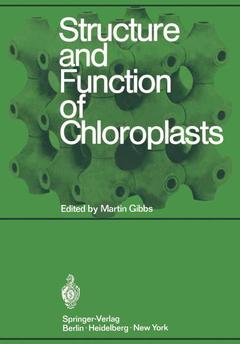Description
Structure and Function of Chloroplasts, Softcover reprint of the original 1st ed. 1971
Coordinator: Gibbs Martin
Language: English
Subjects for Structure and Function of Chloroplasts:
Structure and Function of Chloroplasts
Publication date: 01-1971
Publication date: 01-1971
Structure and Function of Chloroplasts
Publication date: 04-2012
288 p. · 17x24.4 cm · Paperback
Publication date: 04-2012
288 p. · 17x24.4 cm · Paperback
Description
/li>Contents
/li>
It is now about 100 years since the chloroplast has been recognized as the site of photosynthesis in plant cells. The last 20 years have seen a striking increase in interest in the structure and function of the chloroplast. Hastened on by powerful new tools such as the electron microscope and the newer methods of isolation and analysis of chloroplasts, there is presently considerable experimental work on the properties of this organelle. In such a rapidly moving field and one which is reviewed systematically is various Annual Reviews, it is not possible to present a detailed critique of the prolific literature in a book of reasonable size. Rather the decision was made to sacrifice complete coverage of the field and to indicate general areas of investigation. In organization, problems here dealt with, are those concerned with the electron microscopy of chloroplast structure, development and conformation, genetic control of chloroplast development, characterization of some of the major components of the chloroplast and the biochemical properties of the chloroplast including the for mation of adenosine triphosphate and reduced pyridine nucleotide and the assim ilation of carbon dioxide into carbohydrate with subsequent conversion to second ary products. A historical outline on the general subject "Photosynthesis and the Chloroplast" has been included to place into proper perspective the rapid developments in the several areas covered in the book. I am particularly indebted to Dr. Roy E.
Historical Outline.- Photosynthesis and the Chloroplast.- The Ultrastructure of Plastids.- A. Introduction.- B. Proplastids.- C. Amyloplasts, Proteinoplasts, and Elaioplasts.- D. Chloroplasts.- E. Chromoplasts.- F. Literature.- Light-Induced Chloroplast Contraction and Movement.- A. Introduction.- B. Changes in Chloroplast Shape.- C. Light-Induced Chloroplast Movements.- D. Literature.- Plastid Inheritance and Mutations.- A. Introduction.- B. Inheritance of Chloroplast Mutations.- C. Nature of the Plastome.- D. The Genetic Control of Chloroplast Development and Function.- E. Concluding Remarks.- F. Literature.- Nucleic Acids and Information Processing in Chloroplasts.- A. Introduction.- B. Information Storage.- C. Information Replication.- D. Information Transcription.- E. Information Translation.- F. Information Processing in Acetabularia Plastids.- G. Literature.- Lipids of Chloroplasts.- A. Phospholipids of Chloroplasts.- B. Glycolipids of Chloroplasts.- C. ?-Linolenic Esters in Lipids of Oxygen-Producing Chloroplasts.- D. The Plant Sulfolipid.- E. Deacylation of Chloroplast Lipids.- F. “Osrrnophilic” Lipid Globules of Chloroplasts.- G. Assembly of Chloroplast Lipoprotein.- H. Reconstitution of Chloroplast Membrane Lipoprotein.- I. Literature.- Biochemistry of Photophosphorylation.- A. Historical Introduction.- B. Electron Flow Patterns.- C. Coupling of Phosphorylation to Electron Flow.- D. Phosphorylation Inhibitors.- E. Partial Reactions Requiring a High Energy State.- F. Photophosphorylation in vivo.- G. Literature.- Carbohydrate Metabolism by Chloroplasts.- A. Isolation of Chloroplasts.- B. Compounds Formed during Photosynthetic CO2 Assimilation and Their Intramolecular Labeling Patterns.- C. Enzymes Catalyzing the Reduction of CO2 to Carbohydrate.- D.Stoichiometry of Photosynthesis Measured in the Chloroplast.- E. Kinetics of CO2 Fixation.- F. Factors Controlling the Reduction of CO2 to Carbohydrate.- G. Literature.- Biosynthesis by Chloroplasts.- A. Proteins.- B. Lipids.- C. Chloroplast Pigments.- D. Chloroplast Quinones.- E. Polyprenols.- F. Sterols.- G. Regulation of Terpenoid Synthesis.- H. Literature.
© 2024 LAVOISIER S.A.S.




